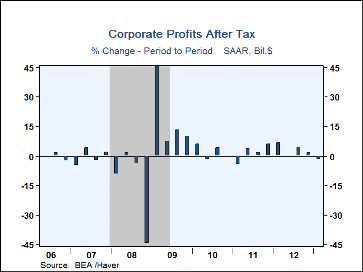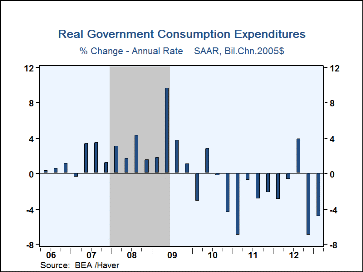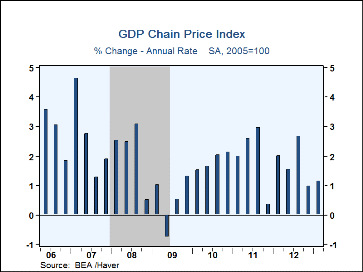 Global| May 30 2013
Global| May 30 2013U.S. GDP Growth Remains Moderate but Profits Decline
by:Tom Moeller
|in:Economy in Brief
Summary
Real GDP growth for last quarter was marginally revised to 2.4% (1.8% y/y) from the advance estimate of a 2.5% rise. Nevertheless, growth still improved from 0.4% at the end of the year. Expectations were for a 2.5% gain. Fewer [...]
Real GDP growth for last quarter was marginally revised to 2.4% (1.8% y/y) from the advance estimate of a 2.5% rise. Nevertheless, growth still improved from 0.4% at the end of the year. Expectations were for a 2.5% gain. Fewer military outlays and a smaller deterioration in the foreign trade account restrained growth last quarter. Inventory rebuilding, consumer spending and residential investment were firm. The increase in the GDP chain price index also was little-revised at a modest 1.1% (1.6% y/y).
Posted for the first time, after tax corporate profits fell 2.0% (+4.0% y/y) following a 1.8% Q4 rise. The decline reflected weakness across sectors. Rest of world profits fell 7.3% (+4.1% y/y), domestic nonfinancial earnings were off 0.8% (+2.8% y/y) while earnings in the financial sector slipped 0.4% (+5.3% y/y).
The effect on GDP growth from inventory rebuilding was lessened to 0.6 percentage points from 1.0 points. This still did not recoup the 1.5 point subtraction during Q4. Trade deficit deterioration, however, lowered growth by a reduced 0.2 percentage points. It occurred as imports rose at an easier 1.9% rate (-0.1% y/y) while exports rose at a 0.8% rate (1.1% y/y), also lessened from the initial tally.
Final sales to domestic purchasers grew at an unrevised 1.9% rate (1.7% y/y). The advance continued to be held back by a 4.9% decline (-2.3% y/y) in government purchases. This drop reflected a 12.1% shortfall (-6.3% y/y) in national defense spending. It was accompanied by a deepened 2.4% decline (-1.2% y/y) in state & local government outlays.
Growth in final sales to private domestic purchasers was unrevised at a firm 3.3% (2.6% y/y). That followed Q4's 3.6% increase. Consumer spending rose at a firmed 3.4% rate (2.1% y/y) led by a lessened 9.1% advance (7.3% y/y) in motor vehicle purchases. Consumption of home furnishings growth, however, was raised to 5.2% (3.6% y/y) while apparel consumption increased a little-changed 1.7% rate (0.1% y/y). Residential investment growth continued strong at a slightly-lessened 12.0% rate (12.8% y/y). Business fixed investment growth remained easier at 2.2% (4.1% y/y) following a 13.1% rise during Q4.
The GDP chain price index grew at a modest and marginally-changed 1.1% rate (1.6% y/y). That followed a 1.0% Q4 rise. This modest gain was largely influenced by a 1.0% increase (1.2% y/y) in the PCE price index, held back by lower energy prices. A firmed 6.7% rise (3.5% y/y) in the residential price index was countered by an unchanged 0.6% uptick (1.0% y/y) in the business fixed investment price index.
The latest GDP figures can be found in Haver's USECON and USNA databases; USNA contains basically all of the Bureau of Economic Analysis' detail on the national accounts, including the new integrated economics accounts and the recently added GDP data for U.S. Territories. The Consensus estimates can be found in AS1REPNA.
| Chained 2005 $, %, AR | Q1'13 (2nd Estimate) | Q1'13 (Advance) | Q4'12 | Q3'12 | Q1 Y/Y | 2012 | 2011 | 2010 |
|---|---|---|---|---|---|---|---|---|
| Gross Domestic Product | 2.4 | 2.5 | 0.4 | 3.1 | 1.8 | 2.2 | 1.8 | 2.4 |
| Inventory Effect | 0.6 | 1.0 | -1.5 | 0.7 | -0.1 | 0.2 | -0.2 | 1.5 |
| Final Sales | 1.8 | 1.5 | 1.9 | 2.4 | 1.9 | 2.1 | 2.0 | 0.9 |
| Foreign Trade Effect | -0.2 | -0.5 | 0.3 | 0.4 | 0.2 | 0.1 | 0.2 | -0.4 |
| Domestic Final Sales | 1.9 | 1.9 | 1.5 | 1.9 | 1.7 | 1.9 | 1.8 | 1.3 |
| Demand Components | ||||||||
| Personal Consumption | 3.4 | 3.2 | 1.8 | 1.6 | 2.1 | 1.9 | 2.5 | 1.8 |
| Business Fixed Investment | 2.2 | 2.1 | 13.1 | -1.8 | 4.1 | 8.0 | 8.6 | 0.7 |
| Residential Investment | 12.0 | 12.6 | 17.5 | 13.6 | 12.8 | 12.1 | -1.4 | -3.1 |
| Government Spending | -4.9 | -4.1 | -7.0 | 3.9 | -2.3 | -1.7 | -3.1 | 0.6 |
| Chain-Type Price Index | ||||||||
| GDP | 1.1 | 1.2 | 1.0 | 2.7 | 1.6 | 1.8 | 2.1 | 1.3 |
| Personal Consumption Expenditures | 1.0 | 0.9 | 1.6 | 1.6 | 1.2 | 1.8 | 2.4 | 1.9 |
| PCE less Food & Energy | 1.2 | 1.2 | 1.0 | 1.1 | 1.3 | 1.7 | 1.4 | 1.5 |
Tom Moeller
AuthorMore in Author Profile »Prior to joining Haver Analytics in 2000, Mr. Moeller worked as the Economist at Chancellor Capital Management from 1985 to 1999. There, he developed comprehensive economic forecasts and interpreted economic data for equity and fixed income portfolio managers. Also at Chancellor, Mr. Moeller worked as an equity analyst and was responsible for researching and rating companies in the economically sensitive automobile and housing industries for investment in Chancellor’s equity portfolio. Prior to joining Chancellor, Mr. Moeller was an Economist at Citibank from 1979 to 1984. He also analyzed pricing behavior in the metals industry for the Council on Wage and Price Stability in Washington, D.C. In 1999, Mr. Moeller received the award for most accurate forecast from the Forecasters' Club of New York. From 1990 to 1992 he was President of the New York Association for Business Economists. Mr. Moeller earned an M.B.A. in Finance from Fordham University, where he graduated in 1987. He holds a Bachelor of Arts in Economics from George Washington University.












